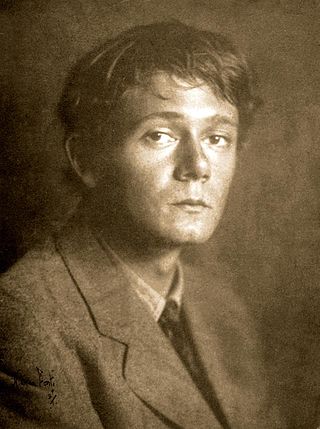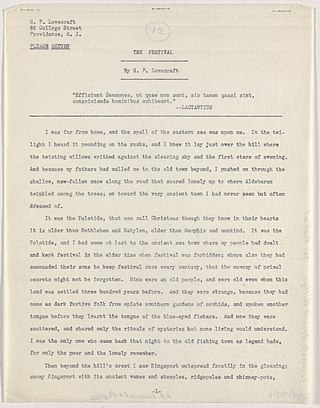Related Research Articles

The Cthulhu Mythos is a mythopoeia and a shared fictional universe, originating in the works of Anglo-American horror writer H. P. Lovecraft. The term was coined by August Derleth, a contemporary correspondent and protégé of Lovecraft, to identify the settings, tropes, and lore that were employed by Lovecraft and his literary successors. The name "Cthulhu" derives from the central creature in Lovecraft's seminal short story "The Call of Cthulhu", first published in the pulp magazine Weird Tales in 1928.

Clark Ashton Smith was an influential American writer of fantasy, horror, and science fiction stories and poetry, and an artist. He achieved early recognition in California for traditional verse in the vein of Swinburne. As a poet, Smith is grouped with the West Coast Romantics alongside Joaquin Miller, Sterling, and Nora May French and remembered as "The Last of the Great Romantics" and "The Bard of Auburn". Smith's work was praised by his contemporaries. H. P. Lovecraft stated that "in sheer daemonic strangeness and fertility of conception, Clark Ashton Smith is perhaps unexcelled", and Ray Bradbury said that Smith "filled my mind with incredible worlds, impossibly beautiful cities, and still more fantastic creatures". Additional writers influenced by Smith include Leigh Brackett, Harlan Ellison, Stephen King, Fritz Lieber, George R. R. Martin, and Donald Sidney-Fryer.

The Necronomicon, also referred to as the Book of the Dead, or under a purported original Arabic title of Kitab al-Azif, is a fictional grimoire appearing in stories by the horror writer H. P. Lovecraft and his followers. It was first mentioned in Lovecraft's 1924 short story "The Hound", written in 1922, though its purported author, the "Mad Arab" Abdul Alhazred, had been quoted a year earlier in Lovecraft's "The Nameless City". Among other things, the work contains an account of the Old Ones, their history, and the means for summoning them.

Azathoth is a deity in the Cthulhu Mythos and Dream Cycle stories of writer H. P. Lovecraft and other authors. He is the supreme deity of the Cthulhu Mythos and the ruler of the Outer Gods, and may also be seen as a symbol for primordial chaos, therefore being the most powerful entity in the entirety of the Cthulhu Mythos.

Tsathoggua is a supernatural entity in the Cthulhu Mythos shared fictional universe. He is the creation of American writer Clark Ashton Smith and is part of his Hyperborean cycle.

At the Mountains of Madness is a science fiction-horror novella by American author H. P. Lovecraft, written in February/March 1931. Rejected that year by Weird Tales editor Farnsworth Wright on the grounds of its length, it was originally serialized in the February, March, and April 1936 issues of Astounding Stories. It has been reproduced in numerous collections.
The Hyperborean cycle is a series of short stories by Clark Ashton Smith that take place in the fictional prehistoric setting of Hyperborea. Smith's cycle takes cues from his friends, H. P. Lovecraft and Robert E. Howard and their works.

Lovecraftian horror, also called cosmic horror or eldritch horror, is a subgenre of horror, fantasy fiction and weird fiction that emphasizes the horror of the unknowable and incomprehensible more than gore or other elements of shock. It is named after American author H. P. Lovecraft (1890–1937). His work emphasizes themes of cosmic dread, forbidden and dangerous knowledge, madness, non-human influences on humanity, religion and superstition, fate and inevitability, and the risks associated with scientific discoveries, which are now associated with Lovecraftian horror as a subgenre. The cosmic themes of Lovecraftian horror can also be found in other media, notably horror films, horror games, and comics.

"The Festival" is a short story by H. P. Lovecraft written in October 1923 and published in the January 1925 issue of Weird Tales.
Demonbane is a Japanese visual novel series by Nitroplus with mecha and Cthulhu Mythos elements. Beginning as an eroge visual novel for the PC, it was ported into a PlayStation 2 non-eroge remake, and spawned a sequel visual novel, a prequel novel, an anime television adaptation and a conversion to manga. An English version of the original Demonbane PC game was released by JAST USA. The anime is currently streamed with English subtitles by Crunchyroll.
A Cthulhu Mythos anthology is a type of short story collection that contains stories written in, or related to, the Cthulhu Mythos genre of horror fiction launched by H. P. Lovecraft. Such anthologies have helped to define and popularize the genre.
Necronomicon Press is an American small press publishing house specializing in fiction, poetry and literary criticism relating to the horror and fantasy genres. It is run by Marc A. Michaud.
Harley Warren is a fictional character created by H. P. Lovecraft, based on his friend Samuel Loveman (1887–1976). Lovecraft had a dream about Loveman, which inspired him to write the short story "The Statement of Randolph Carter" in 1919. In the story, Warren is a mysterious occultist and friend of Carter, who suffers a gruesome but undefined fate while exploring a crypt in Big Cypress Swamp.

Beyond the Wall of Sleep is a collection of fantasy, horror and science fiction short stories, poems and essays by American author H. P. Lovecraft. It was released in 1943 and was the second collection of Lovecraft's work published by Arkham House. 1,217 copies were printed. The volume is named for the Lovecraft short story "Beyond the Wall of Sleep".

Out of Space and Time is a collection of fantasy, horror and science fiction short stories by American writer Clark Ashton Smith. It was released in 1942 and was the third book published by Arkham House. 1,054 copies were printed. A British hardcover appeared from Neville Spearman in 1971, with a two-volume paperback reprint following from Panther Books in 1974. Bison Books issued a trade paperback edition in 2006.
Bryce John Stevens is a horror writer, illustrator and editor. He grew up in Christchurch, New Zealand and moved to Sydney in the mid-1980s. From childhood he was fascinated with the supernatural and terrifying consequences of events from stories such as "The Tinderbox", a predilection which continued through his high school years and beyond.
"History of the Necronomicon" is a short text written by H. P. Lovecraft in 1927, and published in 1938. It describes the origins of the fictional book of the same name: the occult grimoire Necronomicon, a now-famous element of some of his stories. The short text purports to be non-fiction, adding to the appearance of "pseudo-authenticity" which Lovecraft valued in building his Cthulhu Mythos oeuvre. Accordingly, it supposes the history of the Necronomicon as the inspiration for Robert W. Chambers' The King in Yellow, which concerns a book that overthrows the minds of those who read it.
References
- ↑ Smith, Don G. (2006). H.P. Lovecraft in Popular Culture. Jefferson, NC: McFarland & Company. p. 32. ISBN 978-0-7864-2091-9.
- ↑ Steve Behrends. Clark Ashton Smith (Starmont Reader's Guide 49). Mercer Is, WA: Starmont House, 1990, pp 67-68.
- ↑ Mitchell, Charles P. (2001). The Complete H.P. Lovecraft Filmography. Greenwood Publishing Group. p. 6. ISBN 0-313-31641-4.
- ↑ This is incorrect, however, since Frank Belknap Long included a quote from the Necronomicon in his The Space-Eaters in 1928.
- ↑ Prescott, Orville (31 January 1945). "Books of the Times". The New York Times .
- ↑ Field, Louise Maunsell (9 August 1942). "Tales of Horror: Out of Space and Time". The New York Times .
- ↑ Colavito, Jason (2008). Knowing Fear: Science, Knowledge and the Development of the Horror Genre. Jefferson, N.C.: McFarland & Company. p. 193. ISBN 978-0-7864-3273-8.
- ↑ "CLARK ASHTON SMITH'S, RETURN OF THE SORCERER – READY BY ANTHONY D. P. MANN, SCORE BY SEIZON". Cadabra Records. 2018-04-27. Retrieved 2018-05-17.
- ↑ "Anthony D.P. Mann". IMDb. Retrieved 2018-05-17.
- ↑ "Return of the Sorcerer (LP), by Seizon (Renato Zampieri)". Seizon. Retrieved 2018-05-17.